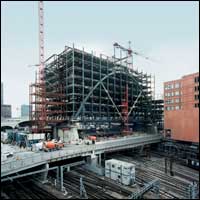Considering that the total investment across all infrastructure sectors in the country during 2012-13 stood at Rs. 534,645 crore, the least since 2010-11, a recently released report by Deloitte Touche Tohmatsu India Private Limited and the Private Equity and Venture Capital Association of India raises concern over the ambitious target set by the government to attract investment of Rs. 65 lakh crore (at current prices) into the infrastructure sector during the Twelfth Five-Year Plan.
Titled ‘Indian Infrastructure – A Trillion Dollar Opportunity’, the report attributes the fall in investment to the less than satisfactory performance of sectors such as power and road and bridges.
In 2012-13, the country’s GDP grew at a decadal low of 5 percent, impacting infrastructure spending. Given that the overall economic sentiment continues to be poor, 2013-14 is not expected to be any better. Prime Minister Dr. Manmohan Singh had earlier stated that he expected economic growth in 2013-14 at 5 percent, similar to that in 2012-13.
Analyzing the multiple issues that plague the infrastructure sector since the last few years, the report states that a domino effect had led to the present state of affairs. It implies that all the problems concerning the sector are interconnected with one issue leading to another.
Several factors including policy paralysis, impact on project viability, demand slowdown and absence of adequate dispute resolution framework to deal with complex issues had led to the fall in infrastructure investment, says the report. In addition, it points out that many other issues resulted in the current situation where new projects are not being initiated, under construction projects face delays and operational projects are getting distressed.
The report cites examples of the other issues negatively impacting infrastructure projects. The increased prices of imported coal had an adverse affect on viability of power projects. Similarly, many of the road projects for which developers had resorted to aggressive bidding and quoted hefty premium could not achieve financial closure and ended up unviable.
According to the report, the government seems to be adopting a three pronged approach to resolve the various issues facing the infrastructure sector. Firstly, the modification of regulatory framework is under consideration and dispute resolution mechanisms being worked out to deal with the dynamic nature of infrastructure projects. Secondly, in case of existing projects, the process of granting clearances is being speeded up and measures initiated to remove execution bottlenecks. Lastly, new projects are being awarded to reinvigorate the capex cycle.
With regard to the country’s ability to meet the infrastructure investment target of Rs. 65 lakh crore as envisaged in the Twelfth Five-Year Plan, the report stresses on two important factors – availability of funds in the form of contribution from the public sector (budgetary support – Rs. 16,143 billion, internal generation – Rs. 6,869 billion and borrowings – Rs. 10,693 billion) and private sector (internal generation – Rs. 9,630 billion and borrowings – Rs. 21,670 billion) and the capacity of the private sector to execute infrastructure projects and take up new investments under the Public Private Partnership model.
“Assuming 50 percent of the investment will be met by budgetary resources, the balance Rs. 32.5 lakh crore needs to be met through debt and equity. Until recently infrastructure investment in India was financed almost entirely by the public sector— from the government budgetary allocations and internal resources of public sector infrastructure companies. However lately, the private sector has emerged as a significant player in bringing in investment to build and operate infrastructure assets from roads to ports and airports and to network industries such as telecom and power. Private investment constituted about one third of infrastructure investment in the Eleventh Plan and this is projected at 50 percent for the Twelfth Plan period. In these times of tight fiscal environment, private sector will need to play a greater role without which infrastructure development will not meet the growing demand and could fall far behind current requirements impacting targeted GDP growth,” says the report.
The report goes on to mention the various factors that are going to influence the three sources of public sector contribution for infrastructure. As far as budgetary support is concerned, it would depend on the fiscal space available to both the Centre and state governments after meeting contractual obligations such as interest payments, wages and salaries and pensions. The Centre’s fiscal space would be further impacted by the expenditure incurred on defence and security as well as subsidies and massive expansion programmes aimed at social entitlements. Higher levels of internal generation of resources largely depend on the extent of freedom and autonomy enjoyed by public sector undertakings involved in rendering infrastructure services to run their undertakings on commercial considerations. Scope for borrowings would mainly depend on government’s success in containing fiscal deficit.
For the infrastructure investment target of Rs. 65 lakh crore under the Twelfth Five-Year Plan, the report estimates the availability of debt at Rs. 13,337 billion as against a requirement of Rs. 32,363 billion.
Given the gap in debt funding, the report suggests increasing reliance on the bond market as an alternative source of financing to bank loans and fiscal consolidation as a means of freeing up bank lending and reducing upward pressure on interest rates in order to meet the infrastructure investment target.











